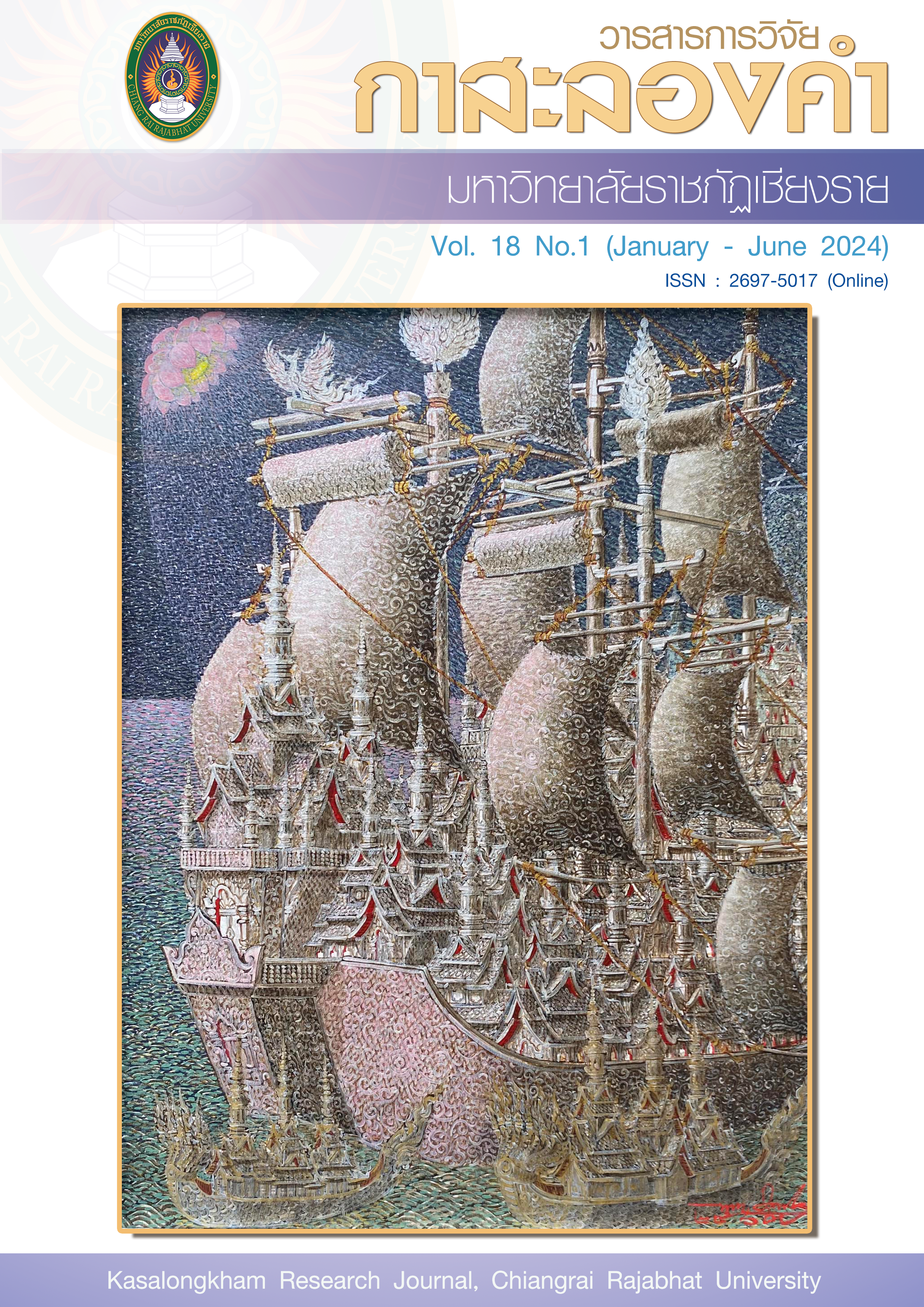The Causal Relationship Model between Business Innovation Orientation, Entrepreneurial Capacity, Entrepreneurial Opportunity and Performance of Startup Firms in Thailand
Keywords:
Business Innovation Orientation, Startup Firms, Entrepreneurial Capacity, Performance, Entrepreneurial OpportunityAbstract
This research aims to investigate the causal relationship model between business innovation orientation, entrepreneurial capacity, entrepreneurial opportunity and performance of entrepreneurs of Startup Firms, by using a questionnaire as an instrument for collecting data from 300 entrepreneurs of Startup Firms in Thailand; The variables consisted of one exogenous latent variable Business Innovation Orientation; and three endogenous latent variables: Entrepreneurial Capacity, Entrepreneurial Opportunity, Performance. These latent variables were measured by 15 observed variables. All the composite reliability values of questionaire ranged from 0.912 to 0.947 and all the average variance extracted values ranged from 0.776 to 0.845. Data was analyzed by SEM.
The results show that the highest-level factor influencing the entrepreneurial capacity directly influenced entrepreneurial opportunity. In addition, subordinate highest-level factor influencing the business innovation orientation directly influenced entrepreneurial capacity. Moreover, the results found that the measurement model was in congruence with the empirical data. This model exhibits goodness of fit. Therefore, entrepreneurs of startup firms in Thailand should develop their entrepreneurial capacities by giving importance to acquiring new innovation resources to the developing product innovation, management innovation, marketing innovation, finance and accounting innovation capability to create a competitive advantage and higher performance. However, the variables in the structural equation model can explain the performance of entrepreneurs of Startup Firms by coefficient of determination (percentage = 86.70, 82.10, and 89.10).
References
Aaker, D. A., Kumar, V. & Day, G. S. (2001). Marketing Research. New York: John Wiley and Son.
Afriany, A. N., Ardiyanto, F., Sumantika, A. & Prakosa, A. (2021). An Entrepreneurial Capacity
Highlight In Feather Duster SMEs, Karanglo Village, Klaten Selatan District. Journal of
Physics: Conference Series, 1823(2021), 1-5.
Awolaja, A.M. (2020). Entrepreneurial Opportunity and Collaborative Research Efforts as
Panaceas for Improving Academic Entrepreneurship Among Ekiti State University Staff.
Archives of Business Research, 8(3), 42-52.
Ayinaddis, S. G. (2023). The effect of innovation orientation on firm performance: evidence
from micro and small manufacturing firms in selected towns of Awi Zone, Ethiopia.
Journal of Innovation and Entrepreneurship, 12(26), 1-19.
Barclay, D., Higgins, C. & Thompson, R. (1995). The partial least squares (PLS) approach to
causal modeling:Personal computer adoption and use as an illustration. Technology
studies, 2(2), 285-309.
Barney, J. (1991). Firm Resources and Sustained Competitive Advantage. Journal of
Management, 17, 99-120.
Chhabra S., Callander, N., Watts, N.L., Costa, L.J., Thapa, B., Kaufman, J.L., Laubach, J., Sborov,
D.W., Reeves, B., Rodriguez, C., Chari, A., Silbermann, R., Anderson, L.D. Jr, Bal, S.,
Dhakal, B., Nathwani, N., Shah, N., Medvedova, E., Bumma, N., Holstein, S.A., Costello,
C., Jakubowiak, A., Wildes, T.M., Schmidt, T., Orlowski, R.Z., Shain, K.H., Cowan, A.J.,
Dholaria, B., Cornell, R.F., Jerkins, J.H., Pei, H., Cortoos, A., Patel, S., Lin, T.S., Usmani,
S.Z., Richardson, P.G., & Voorhees, P.M. (2023). Stem Cell Mobilization Yields with
Daratumumab- and Lenalidomide-Containing Quadruplet Induction Therapy in Newly
Diagnosed Multiple Myeloma: Findings from the Master and Griffin Trials.
Transplantation and Cellular Therapy, 29(3), 1-10.
Chow, W.S. & Chan, L.S. (2008). Social network, social trust and shared goals in organizational knowledge sharing. Information and
Management, 45(7), 458-462.
Dankwah, J.B., Nnindini, S.I. & Bukari, Z. (2024). Innovation orientation and firms' financial
performance: The moderating role of new product development Innovation
orientation and firms' financial performance: The moderating role of new product
development. Cogent Business & Management, 11(1), 1-16.
Fan, J. & Su, J. (2021). Influence of Social Network Strength on Entrepreneurial Opportunity
Recognition: A Chain Mediation Model of Need Knowledge and Technological
Knowledge. Discrete Dynamics in Nature and Society, 2021, 1-10.
Farooq, R., Vij, S. & Kaur, J. (2021). Innovation orientation and its relationship with business
performance: moderating role of firm size. Measuring Business Excellence, 25(3), 1-19.
Fornell, C. & Larcker, D.F. (1981). Evaluating structural equation models with unobservable
variables and measurement error. Journal of Market Research, 18(1), 39-50.
Gao, H. & Raju, V. (2023). Entrepreneur Ability and Firm Growth: A Review Paper. Journal of
Reproducible Research, 1(1), 61-66.
Gumel. B.I. (2018). Critical Factors Influencing Opportunity Recognition and Exploitation.
International Journal of Contemporary Research and Review, 9(4), 20748-20759.
Hair, J.F., Black, W.C., Babin, B.J. & Anderson, R.E. (2010). Multivariate data analysis: A global
perspective (7th ed.). New Jersey: Pearson Education Inc.
Jungang, W. (2023). The Effect of Product Innovation and Product Variations on Consumer
Buying Interest. Siber International Journal of Digital Business (SIJDB), 1(1), 25-33.
Kamau, A. ., Nkaabu, C., & Cherono, V. . (2023). Innovation Orientation and Firm Performance:
The Role of Organizational Commitment among Commercial Banks in Meru County,
Kenya. Human Resource and Leadership, 3(1), 29–47.
Kastelli, L., Siokas, G. & Tsakanikas, A. (2023). Entrepreneurial Absorptive Capacity as Enabler
of Knowledge Intensive Entrepreneurship: An Empirical Investigation. Journal of the
Knowledge Economy, 2023, 1-32
Khin, S. & Lim, T.H. (2018). Entrepreneurial opportunity recognition, Exploitation and new
venture success: Moderating role of prior market and Technology knowledge.
International Journal of Entrepreneurship, 22(4), 1-6.
Kuckertz, A., Hinderer, S. & Röhm, P. (2019). Entrepreneurship and entrepreneurial
opportunities in the food value chain. Science of Food, 3(1), 6.
Li, Z., Jiang, B., Bi, S., Feng, J. & Cui, Q. (2022). Impact of different types of entrepreneurial alertness
on entrepreneurial opportunities identification. Frontiers in Psychology, 13, 1-19.
Lv, R.W., Lai, C. and Liu, J. (2015). Entrepreneurial Capability Scale and New Venture Performance: The Moderating Role of Entrepreneurship education. Mediterranean Journal of Social Sciences, 7(1), 97-104.
Mohedano-Suanes, A., Revilla-Camacho, M. A. & Garzón, D. (2021). Innovation orientation and
long-term performance: The mediating role of market perception capability.
International Entrepreneurship and Management Journal, 17(1), 741–757.
Musawa, M.S., & Ahmad, K. (2019). Entrepreneurial Orientation and Innovation Performance:
The Moderating Role of Competitive Environment. Journal of Global Economics, 7(1), 1-7.
Nawir, C.P. & Christiani, N. (2019). The Effect of Entrepreneurial Passion and Opportunity
Awareness toward the Sustainability of Startup Businesses. Journal of Entrepreneur
and Entrepreneurship, 8(1), 33-40.
National Innovation Agency (Public Organization). (2023). sarup 3 praden samkhan chak ngan SITE
pakmut phatna sattat up thai ok su talatlok. Retrieved March 16, 2023, from https://nia.or.th/Thai-Startup-2023. (In Thai)
Nunnally, J.C. (1978). Psychometric theory. New York: McGraw-Hill.
Nunnally, J.C. & Bernstein, I.H. (1994). Psychometric Theory. (3rd ed.). New York, NY:McGraw-Hill.
Oyson, M. J. (2014). Entrepreneurship in Small Firm Internationalisation. (degree of Doctor of
Philosophy in Management Thesis). The University of Auckland.
Rachmawati, R. & Widowati. (2021). Research of the Impact of Financial Dimensions and Entrepreneurial Capacity on Business
Performance in Small and Medium Enterprises In Central Java. Universal Journal of Accounting and Finance, 9(1), 122-129.
Rattanasombat, B. (2023). Thunkit lae prathet chatoepto tong chai nawatkam lae kan talat pen Tuanam Retrieved August 2, 2023, from
https://www.bangkokbiznews.com/business/economic/1074309. (In Thai)
Schumacker, R. E. & Lomax, R. G. (2010). A beginner’s guide to structural equation modeling. (3rd ed). New Jersey: Lawrence Erlbaum Associates.
Soelaiman, L. & Liediana, L. (2020). Factors Affecting Entrepreneurial Opportunity Recognition Among Food and Beverage SMEs. Advances in Economics, Business
and Management Research, 174, 501-507.
Stanić, M. (2020). Decoding the Entrepreneurial Capacity: The Case of Entrepreneurial Alertness. Zagreb International Review of Economics & Business, 23, 1-12.
Stock, G.N., McDermott, C. & McDermott, M. (2018). Early Stage Venture Strategy and the Survival of Nascent Entrepreneurial Firms: A Sand Cone Model Approach.
IEEE Engineering Management Review, 46(3), 108-116.
Suriyawong, S., Panthai, B., Gatesa, T., Amornratanasak, S., Ruangsri, S. and Sethawong, P. (2008). Educational Research and Statistics: wichai lae sathiti thang kan
suek sa (3rd ed). Bangkok: Academic promotion center publishing. (In Thai)
Taleb, S.T.T., Hashim, N. & Zakaria, N. (2023). Entrepreneurial Leadership and Entrepreneurial Success: The Mediating Role of Entrepreneurial Opportunity
Recognition and Innovation Capability. Sustainability, 15(7), 1-17.
Technology and Innovation Based Enterprise Development Fund. (2023). Rai ngan pra cham Pi 2565 Annual Report 2022. Retrieved August 20, 2023, from
https://tedfund.mhesi.go.th/images/news/reports/2565/ARTED2022.pdf (In Thai)
Thoumrungroje, A. & Racela, O.C. (2022). Innovation and Performance Implications of Customer-Orientation across Different Business Strategy Types. Journal of
Open Innovation: Technology, Market, and complexity, 8, 178.
Zhang, H., Hu, L. & Kim, Y. (2023). How Does Iteration of Entrepreneurial Opportunities in User Enterprises Affect Entrepreneurial Performance? A Dual Case Study
Based on Dual Strategic Orientations. Systems, 11(9), 1-21.

Downloads
Published
How to Cite
Issue
Section
License
Copyright (c) 2024 KASALONGKHAM RESEARCH JOURNAL, Chiang Rai Rajabhat University

This work is licensed under a Creative Commons Attribution-NonCommercial-NoDerivatives 4.0 International License.

 e-ISSN:
e-ISSN: 

